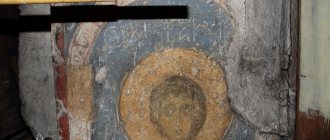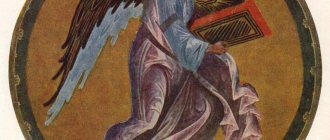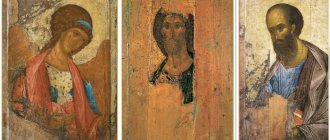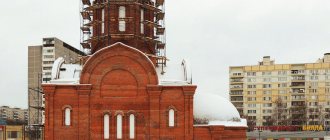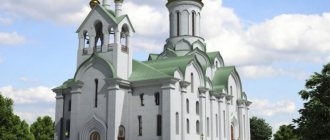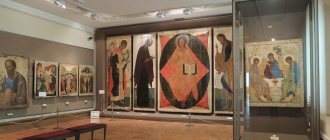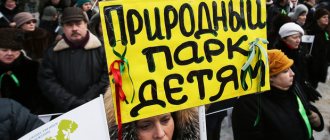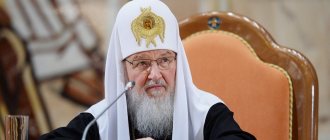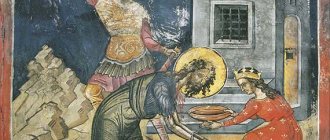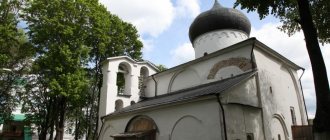The Andrei Rublev Museum is the largest collection of works of ancient Russian art. More than 13 thousand exhibits are stored here - icons, frescoes, handwritten and early printed books, sculptures, artistic castings and sewing.
This year the museum celebrates its 60th anniversary. We invite you to get acquainted with an unusual part of the museum’s collection - ancient frescoes from churches destroyed over the years. Among the surviving paintings are early works by the 15th-century icon painter Dionysius, works by isographers from the Armory of the 17th century, and masters from different cities of Rus'.
Church of the Transfiguration on Nereditsa in Novgorod. Images of saints
Face of Saint Hypatius of Gangra.
A fragment of a painting from the Church of the Savior on Nereditsa in Novgorod. 1199. Gift of George Costakis to the Andrei Rublev Museum The Church of the Transfiguration on Nereditsa in Novgorod was built in 1198 by order of the Novgorod prince Yaroslav Vladimirovich. It was painted a year later by Novgorod icon painters. The fresco complex consisted of four tiers - each of them depicted scenes from the Bible, biblical prophets and saints. Painting covered the entire surface of the walls, pillars and dome vault. In 1862, artist Nikolai Martynov redrew the murals in watercolors. Five years later, the artist was awarded medals for these drawings at the World Exhibition in Paris.
The frescoes of the Church of the Transfiguration became one of the first monuments of ancient Russian art, which became known outside the Russian Empire. In the 19th century, art historians from other countries studied them, and articles about the frescoes were published in various publications.
During the Great Patriotic War, the church was subjected to artillery shelling and was almost destroyed. Part of the walls with frescoes has survived - only about 15% of the original area: images of holy women have been preserved in the deacon, images of the Prophet Elijah and St. Peter of Alexandria have been preserved in the altar, as well as the composition “Baptism” on the southern wall of the church.
After the war, fragments of plaster with paintings were recovered from the rubble. In the Andrei Rublev Museum you can see the images of “Saint Dometian of Meletinsky” and “Saint Hypatius of Gangra”. The frescoes came to the fund from the collection of collector George Costakis.
The Church of the Transfiguration on Nereditsa was restored and in 1992 included in the UNESCO World Heritage List.
History of the development of the fresco (Part 1. Old Russian fresco. Two transformations)
For example, in Sophia of Kyiv, like in no other medieval building, mosaic is combined extremely freely with fresco. The magnificent interior decoration of the cathedral was made by Greek craftsmen, combining mosaics and frescoes. When studying mosaic fragments from Sophia of Kyiv in the 10th-11th centuries. (see photo 4) it can be seen that there are two layers of soil. Before starting the mosaic set, a design was painted on the surface of the first layer of soil. And then, the surface was colored for the future mosaic set. A mosaic module measuring 10x5 mm was pressed into the top layer of soil in such a way that seams up to 3 mm wide remained between the rows, despite the fact that the distance between the module was about 1 mm.
Photo 5. Fragment of a mosaic set of the 11th-12th centuries. Trapezitsa. V. Tarnovo, Bulgaria. (From the collection of V.V. Filatov, 1961)
These features are very similar to those that A. Winner writes about in his book. But there are also differences that are associated with the microchemical composition of the soil. An analysis of its composition shows that the bottom layer does not have any granular filler and is made from lime paste, a dusty fraction of calcareous tuff and a small amount of straw filler. The top layer, into which the cubes of the mosaic set were pressed, has a special addition of ash from straw, probably in order to give a darker color to the seams between the cubes.
On a fragment of a mosaic of the 11th-12th centuries. from V. Tarnovo (Bulgaria), as well as on pieces of soil from Tsromi (Georgia, fragments of mosaic soil, 7th century, see photo 3), it is clearly visible that paint for the future mosaic set was applied to the surface of the soil. As for the soil from V. Tarnovo, which contains only the top layer, which has high strength, it is prepared from long-aged lime with a significant amount of glue, probably gelatin, without filler.
In Sophia of Kyiv, the border between mosaic and fresco passes mainly in the vim and on the dome pillars along the line of the slate cornice. But recent restoration surveys have shown that on the western slopes of the northern and southern girth arches the frescoes were located above this line. There, under mosaic medallions depicting the Sebastian martyrs, there are figures of two martyrs made in fresco technique, which are probably a preparatory drawing. On the entire western girth arch, medallions with half-figures of the Sebastian martyrs are painted using fresco technique. Frescoes decorate the lower part of the vima walls and pillars up to the slate cornice, sometimes extending beyond it. The main core of the fresco decoration in its main parts dates back to the era of Yaroslav. The upper chronological limit of the latest frescoes from this complex is considered to be the 60s of the 11th century.
As for the frescoes of the outer gallery, baptismal chapel and towers, they belong to a different era - to the 12th century.
It is unknown why the work of the mosaicists was interrupted and the mosaic painting was not completed. It is believed that the reason was the desire of Prince Yaroslav to finish painting the temple as soon as possible. From the above, we can draw an important conclusion that the Greek masters who introduced the Byzantine system of wall paintings in the X-XI centuries. did not differentiate between the compositions of the plaster base for mosaic painting or fresco. Using the example of the St. Sophia Cathedral in Kyiv, it is clear that where they could not complete the mosaic set for one reason or another, fresco paintings remained. Thus, by the 12th century in Ancient Rus', artists did not accept the Byzantine system of monumental mosaic painting, but the execution of the plaster base for the mosaic was completely transformed into a system of preparation for the fresco. In order to find out the characteristic technological features of ancient Russian frescoes of the 10th-12th centuries, we studied samples of plaster bases for painting from some surviving monuments of the 12th century, such as:
- Cathedral of St. George in Staraya Ladoga, XII century;
- Spaso-Preobrazhensky Church of the Spaso-Efrosinevsky Monastery in Polotsk, XII century.
Also, samples of painting materials from monuments of Ancient Rus' were studied, which for various reasons have come to us in the form of archaeological fragments:
- Assumption Cathedral in Staraya Ladoga, XII century;
- Church of the Tithes in Kyiv, 10th century,
- Church of the Savior on Nereditsa, 1199,
- refectory of the Kiev-Pechora Lavra, XII century,
- fragment of the external painting of the Assumption Cathedral of the Kiev Pechersk Lavra, end of the 11th century,
- Kyiv St. Sophia Cathedral, XI century.
Results of comparative studies of plaster bases of fresco and mosaic painting of the 10th-12th centuries. show that both types correspond to purely Byzantine technology and are lime-carbonate-cement compositions. These plasters have a characteristic gray, grayish-beige and grayish-pink color due to the mixed composition of fillers consisting of ceramic additives and clayey limestones. It is clear that such a plaster base was initially characteristic only of mosaics, since this type of painting not only did not require pure white bases, but due to the specifics of laying the mosaic module with large seams, it even avoided them. In the X-XII centuries. In Russia, the technology for preparing the plaster base for painting, introduced by Byzantine masters, practically repeated the Roman one, but modified due to the availability of other resources. As is known, Roman plaster mortars were mainly based on volcanic fillers that had hydraulic properties in relation to lime. But in the Eastern Roman Empire there were no sources of volcanic materials, so they were replaced by artificially fired clay, which is also mentioned in the ancient Roman texts of Vitruvius. This tendency to use mosaic soils for fresco painting is well illustrated by the results of studying a number of examples of monumental painting. You can see the structure of the solution of typical Byzantine plaster, for example, by studying a sample of fresco painting from 1199 from the Church of the Savior on Nereditsa (see photo 6 a, b). This dark gray colored plaster is a mixture of lime and travertine limestone.
The transition from the old Byzantine-Roman recipes for plaster bases for painting to new technological techniques that gave frescoes a completely new colorful sound in the Russian technological school of monumental painting occurred at the end of the 14th century. Research shows that this is largely due to the influence of Athos. In the 14th century, the history of Athos was marked by an increase in the number of Slavic monks due to Serbia's dominant position on the Balkan Peninsula. The 14th century on Mount Athos was the time of restoration work on the monasteries destroyed by the crusaders. The monasteries of the Holy Mountain are helped in this by the pious emperors Andronikos II and Andronikos III Palaiologos and the Serbian king Stefan Dusan. The activity of Athonite monks and the influence of their ideals on the spiritual culture of Byzantium and in the Slavic countries was significant, especially since many of them successively occupied the patriarchal throne in Constantinople and Moscow. At the time when the Church of the Eastern Roman Empire was headed for the second time by Patriarch Philotheus, the monk Cyprian, who had previously worked in one of the Athos monasteries, arrived in Constantinople. This probably happened in 1363. Cyprian became the cell attendant of the Patriarch and performed the duties of an apocrisiary under him - the diplomatic position of an envoy. It must be said that the rapprochement of these people did not happen by chance. The fact is that Patriarch Philotheus, installed by Emperor John VI Kantakouzenos, in November 1354 was forced to temporarily leave the patriarchal throne and retire to Athos. John VI, who had abdicated the throne, also retired there, where he took monastic vows under the name of Joasaph Christodoulus. It is believed that Joasaph continued to have a significant influence on the politics of the Eastern Roman Empire for a long time, which was headed after him by John V Palaiologos, under whom John VI Kantakouzenos at one time was regent.
Photo 6 a, b. A sample of painting from 1199 of the Church of the Savior on Nereditsa (a). Microphotograph of a cross section of painted plaster (b) (Photo by the author)
Photo 7. Sample of fresco painting by Dionysius of 1502 from the Nativity Cathedral of the Ferapontov Monastery. Microphotograph of a transverse section of painted plaster. The composition of the plaster is completely carbonized lime, casein (Photo by the author).
Apparently, the rapprochement between the Patriarch of Constantinople Philotheus and the future Metropolitan of Moscow and All Rus' Saint Cyprian took place in one of the monasteries of Athos. And then, around 1373, on the instructions of Patriarch Philotheus, Cyprian was sent to Rus' to reconcile the Lithuanian and Tver princes with the already elderly Metropolitan Alexy. At the same time, at the Council of Constantinople, it was decided that “after the death of St. Alexis, he should become Metropolitan of All Rus'.” But it was not immediately possible for Cyprian to become the successor of St. Alexius at the All-Russian See. Only in 1381, after the Battle of Kulikovo, did Grand Duke Dimitri send Simonov’s abbot Theodore to Kyiv “according to Cyprian” with an invitation to him to Moscow to the metropolitan see. Saint Cyprian of Moscow, the wonderworker of all Russia, who in 1390 became the successor of Saint Alexy at the All-Russian See under Grand Duke Vasily Dimitrievich, headed the Russian Church until 1406. Under Saint Cyprian, many monasteries were founded in the Russian North, church construction developed, and churches were painted throughout Rus'. Autographs of some of the Slavic translations of the saint have been preserved, testifying to his great scientific work. During the reign of Metropolitan Cyprian there occurred the Russian period of the work of Theophan the Greek and the beginning of the creative path of the Rev. Andrei Rublev, which marked a new direction in Russian painting. Their paintings began to differ sharply from the masters of the previous era in their high artistic skill and philosophical and theological professionalism.
These masters of painting mark a new direction in the fine arts, which is associated with the spiritual rise of Rus' after the death of the steppe civilization of the Golden Horde and the premonition of their historical role at the end of the existence of the Eastern Roman Empire. The second transformation in the monumental fine art of Ancient Rus' was expressed not only in stylistic changes in painting, but also in the technology for preparing plaster primers for frescoes. As studies of samples of painting bases from the 15th-16th centuries show. such monuments as:
- frescoes of 1428 of the Spassky Cathedral of the Spaso-Andronikov Monastery;
- frescoes of the 15th century Church of the Assumption of the Mother of God on Gorodok in Zvenigorod;
- frescoes of the Church of the Nativity of the Virgin Mary of the Ferapontov Monastery in 1502 (photo 3);
- frescoes of 1561 of the Cathedral of the Assumption of the Blessed Virgin Mary of the Assumption Monastery in Sviyazhsk;
- frescoes of the 16th century Smolensky Cathedral of the Novodevichy Convent;
- frescoes from the turn of the 16th to 17th centuries. Church of the Transfiguration Bolshiye Vyazemy,
all plaster bases are now white and made of pure lime without fillers (see photo 7). In wall painting, a combined painting technique began to predominate: underpainting was done using the fresco technique, and modeling was done using yolk tempera. Pure lime plaster bases for monumental painting, which appeared at the beginning of the 15th century in Ancient Rus' and had no similarity in composition to Byzantine ones, were made without any fillers and at the same time had high strength. These properties arose due to the special preparation of the lime gesso and the method of its application. Such purely lime bases for frescoes and the technology for their preparation are not common, since the properties of lime necessarily require the introduction of anti-shrink fillers into lime mortars, such as quartz sand, marble, limestone or ceramic chips, as was previously the case. When studying the overwhelming number of samples of ancient Russian painting of the 14th-16th centuries. it was found that in preparing the lime gesso, the method described in the Typica of Bishop Nektarios in 1599 was used:
“And the lime would be old, five or ten years old; and what is older is better.” “Article two also. And the composition of the old masters will be desirable so that the letter will forever be drawn from the gesso according to the same custom as it was written before. And to bring out the emchyuga: pour and cover the whole summer and strain out the days and nights, and by winter, rake the gesso into a heap and row with the cattails. And that winter the gesso will freeze and rest, and the rest of the food will come out of it. And in the new spring, from the great day, soon fill it with liquid water as before, and strain it for about six weeks, and the rest of the container will come out of the gesso. And how the water will become clear on the gesso, and there will be nothing on top, and then <...> that same gesso will be eternal, strong and clean. And how will that gesso keep up with the wall writing, and comb the flax clean so that it is without bones, trim it finely, mix it into the gesso, and the gesso would be much thicker. Yes, crush the spruce bark finely with flour and sow it with a fine sieve, and mix it with barley, boil it in half, and boil it with water in a cauldron, and after boiling, strain with a fine sieve, otherwise the glue will be strong. And pour that glue over the gesso, and sprinkle with pure oatmeal flour and sprinkle with that flour a little. Moreover, I heard that they put cow bile in the same gesso, and with all that they kill it with pestles, so that it is killed much like wheat dough stretches.”
From the text of Typika it becomes clear that the technology for preparing plaster gesso for frescoes is based on long-seasoned lime with the addition of plant fibers and glue. As has been established, long-term exposure of lime, washing and freezing leads to its almost complete carbonization, which does not require the further introduction of anti-shrink fillers. Plaster gesso prepared in this way are layers of a lime composition with a thickness of 15 to 5 mm, pure white, high density and hardness. Interestingly, the thickness of the plaster base decreased from 15-13 mm in the 15th century to 5-7 mm in the 16th-17th centuries. The method of applying them to the walls probably consisted of compacting the plaster base and carefully smoothing the surface of the plaster both before and after finishing the paintings. Research also shows that in all samples of the plaster base of ancient Russian fresco painting of the 12th-16th centuries. organic natural binders are present. So, in the sample of the plaster base of the painting c. Savior on Nereditsa of the 12th century, wall plaster with a paint layer from the excavation near the refectory chamber of the St. Sophia Cathedral in Kyiv, for example, vegetable glue was discovered, which corresponds to the text of the “Typica of Bishop Nektarios”. At the same time, the use of vegetable glue and special preparation of lime was also used in 1642 when painting the Assumption Cathedral of the Moscow Kremlin, which is revealed by studying the “Consumable books of the Armory order for the cathedral wall letter in the Church of the Assumption for 1642-1644.” But in the overwhelming number of studied samples of ancient Russian monumental painting, starting from the 12th century, other natural adhesives were found as binding materials for plasters. Thus, the paintings attributed to the brush of A. Rublev from the Spassky Cathedral of the Spaso-Andronikov Monastery have a distinctive technological feature. Here, blood albumin is identified as the binder of the plaster gesso. And in the plaster bases of the frescoes of the 12th century. Church of St. George in Staraya Ladoga, frescoes of Dionysius from 1502 in the Church of the Nativity of the Virgin Mary of the Ferapontov Monastery, frescoes from the XVI Smolensk Cathedral of the Novodevichy Convent in Moscow, paintings of the Assumption Cathedral on the island-town of Sviyazhsk from 1561, paintings from the Church of the Transfiguration in Bolshiye Vyazemy from 1602 in plaster gesso casein found in milk. The use of casein in lime plasters is also an ancient Roman tradition. For example, Pliny in Book XXXVI of Natural History in Chapter LV reports about the preparation of lime:
“In Elis there is a temple of Minerva, in which brother Phidias Panenus…. applied plaster prepared with milk and saffron....”
The incomplete compliance of the technological aspects of the preparation of plaster gesso for monumental painting with the text of the “Typica of Bishop Nektarios,” which regulates the use of vegetable glue, while studies show the presence of casein, may have its own explanation. The reason that Bishop Nektariy recommends using glue made from barley grains in gesso may be related to the technology that existed at that time for preparing lime masonry mortars. The instruction to use vegetable glue was already in one of the ancient chronicles, “The Tale of St. Sophia of Constantinople”, dating back to the 12th century. This text describes the Byzantine technology for preparing masonry mortars, which talks about boiling barley grains:
“...now we cook the barley porridge again in cauldrons, and with all this the place has become muddled and the inputs have become poor; (c) such sucrose is glued, the trees of g'lemago willow are cut into cauldrons piled with barley; and ' tvorakhou trough ...'
It is interesting that this technology, in fact, coincided with the preparation of plaster gesso for painting in the way the “cunning master” prepared lime mortar for the foundation masonry of the chapel with the addition of vegetable glue obtained in the first centuries after the Baptism of Rus' (plaster of the refectory of the Kiev-Pechora Lavra , XII century, fragment of the external painting of the Assumption Cathedral of the Kiev Pechersk Lavra, end of the XI century).
And when analyzing lime masonry mortars of ancient buildings, vegetable glue is found almost everywhere until the beginning of the twentieth century.
Nativity Cathedral of the Pafnutyevo-Borovsky Monastery. Face of a saint
Fragment of a painting from the Nativity Cathedral of the Pafnutievo-Borovsky Monastery, Kaluga Region. Around 1474. Masters Dionysius and Mitrofan
The Cathedral of the Nativity of the Virgin Mary in the Pafnutyevo-Borovsky Monastery in the Kaluga region was built in 1467. From the Life of Saint Paphnutius it is known that the paintings of the cathedral were carried out by the elders of the Moscow Simonov Monastery Mitrofan and Dionysius - “cunning painters in the Russian land.” Other works of Mitrofan are unknown. Dionysius later became one of the most famous Russian icon painters. The paintings of the Pafnutiev Monastery are the earliest of his known works.
In those days, drawing was done with paints diluted in water or lime. Lime was also added to the plaster, so the paint layer was firmly bound to the base and did not collapse for a long time. In 1586, the temple was dismantled into blocks, which were used in the construction of a new cathedral.
When the building was restored in the 1960s, scientists recovered 29 white stone fragments, some with frescoes. Some of them are now kept in the Andrei Rublev Museum - this is where you can see the preserved face of the saint.
Church of the Nativity of the Virgin Mary of the Mozhaisk Luzhetsky Monastery. Image of Saint Thekla
Saint Thekla. Fragments of paintings from the Cathedral of the Mozhaisky Luzhetsky Monastery, Moscow region. Mid-16th century
The Nativity Cathedral in the Luzhetsky Monastery in Mozhaisk was built in 1542 and was soon decorated with paintings. Researchers suggest that the subjects for the frescoes were chosen by Metropolitan Macarius of Moscow and All Rus' himself.
The temple stood for three centuries. In 1812, soldiers of the Napoleonic army plundered and set fire to it. Some of the frescoes were destroyed by fire. The cathedral was restored only in the middle of the 20th century.
The Andrei Rublev Museum bought a fresco from this temple from one of the Moscow collectors in 2004. It consisted of many small fragments, but art historians established that the fresco depicts Saint Thekla.
Cathedral of the Miracle of the Archangel Michael in the Khoneh Chudov Monastery. Image of the Apostle Peter
Holy Apostle Peter. A fragment of a painting from the Cathedral of the Miracle of the Archangel Michael in the Khoneh Chudov Monastery of the Moscow Kremlin. First half of the 17th century
The stone Cathedral of the Miracle of the Archangel Michael in Khoneh in the Moscow Kremlin was built by Italian architects in 1501–1503. It was painted much later - in the next century.
At the end of 1929, they decided to demolish the temple and build a new Kremlin administrative building on this site. The frescoes were allowed to be removed from the walls, but restorers were able to save only part of the fragments: the temple was blown up at night without warning. The artists restored the paintings that they managed to remove and sent them to museums: the State Tretyakov Gallery, the State Historical Museum and the State Russian Museum. The Andrei Rublev Museum houses two frescoes from this cathedral.
Trinity Cathedral of the Makaryevsky Monastery in Kalyazin. Fragments of paintings
Apocalypse. Painting of the western wall of the Trinity Cathedral of the Makariev Kalyazin Monastery, Tver region. 1654. Archive photo
Holy Apostles. Fragment of a painting from the Trinity Cathedral of the Makariev Kalyazin Monastery, Tver region. 1654
Painting of the southern wall of the Trinity Cathedral of the Makariev Kalyazin Monastery, Tver region. 1654. Archive photo
Makaryev Monastery was founded in the 15th century. For many centuries, Russian rulers came here to venerate the relics of St. Macarius, the founder of the monastery. The five-domed Trinity Cathedral in the monastery was built in 1654 at the expense of Tsar Alexei Mikhailovich. It was painted the same year. Icon painters depicted the holy apostles, the composition “Introduction into the Temple” with images of saints Joachim and Anna, and other biblical scenes. An inscription was left on the wall of the temple, which indicated the names of 17 craftsmen who performed this work. Among them were Vasily Ilyin and Ivan Filatiev, famous icon painters of the Armory Chamber in those years, who had previously decorated the Archangel Cathedral of the Moscow Kremlin.
Trinity Cathedral shared the sad fate of many churches in the Volga region, which were flooded during the construction of hydroelectric power stations. The building ended up at the bottom of the Uglich reservoir. Before the flooding, scientists were able to separate most of the paintings from the walls. The work was carried out in winter: fabric was frozen onto the paint layer and then the plaster was chipped off.
Today, the fragments are kept in various museums around the country. Some of them were picked up by the local antiquities collector V. Troitsky. His daughter donated them to the Andrei Rublev Museum.
Icons
An icon is always painted according to a certain canon and each image has its own rules. Let us briefly describe the images of the main character of the icons - Christ. It is depicted in several main forms:
- Mandylion is the face of Christ on a board;
- Keramidion - the face of Christ on a clay board or tile;
- Pantocrator - a representation of Christ in the form of the Heavenly King and Judge: full-length, sitting on a throne, waist-deep or chest-length; in his left hand he holds the Gospel, with his right he makes a blessing gesture;
- Savior in power - Christ sitting on the throne with a book;
- Savior Emmanuel - the image of Christ at the age of 12;
- Christ the Old Denmi is the Savior in the guise of a gray-haired old man.
Note 1
The first icons in Rus' were those that Prince Vladimir brought from Chersonesus, but not one of them has survived to this day. The oldest surviving icons come from Veliky Novgorod.
In the 11th century The icons “The Golden Robe of the Savior” and “Apostles Peter and Paul” were created for the St. Sophia Cathedral. The first of them is of Byzantine origin and depicts Christ on the throne with the Gospel in his left hand. The second icon, created in Novgorod, depicts the apostles Peter and Paul in full growth. Another example of the oldest Russian icons is “St. George,” created at the end of the 11th and beginning of the 12th centuries. In addition, it is remarkable in that it has two sides: one depicts St. George as a young warrior, and the other depicts the Virgin Hodegetria.
In the 1130s The icons “Ustyug Annunciation” and “St. George” were created (his image was generally very popular in Rus'), created in full height. The icon “Savior Not Made by Hands” with the majestic appearance of Christ dates back to approximately 1191.
An interesting story is connected with the icon of the Mother of God (Vladimir). It came to Rus' from Byzantium at the beginning of the 12th century. as a gift to the Kyiv prince Mstislav. For some time she was in the monastery of Vyshgorod, until in 1155 Andrei Bogolyubsky took her first to his residence in Bogolyubovo, and then to the Assumption Cathedral in Vladimir. In 1395, during the invasion of Tamerlane, it was moved to Moscow for the “divine” protection of the city. Throughout its existence, it was repeatedly taken out of Vladimir and then returned to it. She was considered the main Russian icon and “participated” in important events: according to tradition, from the 16th century. Russian sovereigns were crowned kings at the Vladimir Icon in the Assumption Cathedral, and it was also used in the procedure for electing metropolitans and patriarchs.
Church of the Annunciation of the Blessed Virgin Mary in Yuryevets. Fresco iconostasis
Holy Apostle John the Theologian. Fragment of the painting of the pre-altar wall (iconostasis) from the Church of the Annunciation, Yuryevets, Ivanovo region. First third of the 18th century
Presentation of the Blessed Virgin Mary into the temple. Fragment of the painting of the pre-altar wall (iconostasis) from the Church of the Annunciation, Yuryevets, Ivanovo region. First third of the 18th century
Holy Apostle Paul. Fragment of the painting of the pre-altar wall (iconostasis) from the Church of the Annunciation, Yuryevets, Ivanovo region. First third of the 18th century
The Church of the Annunciation of the Blessed Virgin Mary in Yuryevets, Ivanovo region, was built at the beginning of the 18th century. It became the first stone building in the city. The temple was distinguished by its external decor in the spirit of Moscow churches: the upper part of the walls was decorated with tiles and carved kokoshniks.
The first iconostasis in the church was frescoed. It consisted of five tiers of icons - they were painted directly on the wall that separated the altar from the main part of the temple. Later, a carved gilded iconostasis was built here, which covered the wall paintings.
After the revolution, the building was converted into a bakery, and the frescoes were painted over. In 1952, they began to build the Nizhny Novgorod hydroelectric power station, and the place where the church stood was supposed to flood the reservoir. In 1953, restorers began removing the painting soil from the walls. First, they used the method of freezing the fabric, and then, when the frost subsided, the gauze was attached to flour glue. In total, the researchers managed to preserve two-thirds of the iconostasis. Today it is one of the few surviving fresco iconostases and the only one that can be seen within the walls of a museum, and not in a temple.
Book miniature
With the advent of Christianity in Rus', books became widespread. Over time, Russian masters master the art of designing manuscripts. The Ostromir Gospel is considered the oldest handwritten book in Rus'. It is written in rite, a type of writing derived from the writing of the Greek liturgical books. When decorating, paints mixed with gold were used in a style typical of Byzantine manuscripts of the 10th-11th centuries. In the Ostromir Gospel there are three miniatures depicting the Evangelists John, Luke and Mark. The ornament pattern is never repeated. Anthropomorphic and zoomorphic elements decorating the initials in the Gospel demonstrate the influence of not only the Eastern, but also the Western tradition.
Book art of Novgorod of the 12th century. represented by the Mstislav Gospel, which was commissioned by Prince Mstislav for the Church of the Annunciation at Gorodishche. It contains four miniatures depicting the evangelists, copied from the Ostromir Gospel, but with more detail.
Thus, having adopted Byzantine traditions and adding original features, Russian masters by the 12th century. formed their own artistic tradition, represented by works on religious themes - frescoes, mosaics, icons, book miniatures.
Do you need proofreading or review of academic work? Ask a question to the teacher and get an answer in 15 minutes! Ask a Question
